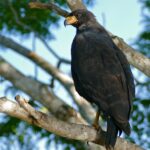The Great Black Hawk (Buteogallus urubitinga) is a large bird of prey that primarily resides in the tropical and subtropical regions of the Americas. This majestic bird has developed a unique set of protective mechanisms to safeguard itself from predators and other threats in its environment.
Habitat Selection: The Key to Survival
The Great Black Hawk typically inhabits riparian forests, mangrove forests, freshwater swamps, marshes, flooded forests, mountain streams, and deserts with abundant perches and shallow water. These diverse habitats provide the bird with ample opportunities to hunt for prey and take advantage of the protective cover offered by the trees and vegetation.
Hunting Techniques: Precision and Agility
 Image source: Great Black Hawk by Bernard DUPONT
Image source: Great Black Hawk by Bernard DUPONT
The Great Black Hawk is a versatile predator that feeds on a wide variety of prey, including fish, reptiles, small mammals, and invertebrates. It hunts by watching for prey from perches that overhang shallow parts of streams and rivers, then dropping onto it. The bird also engages in “herding” prey into shallower water by walking and waving its wings. This hunting strategy allows the hawk to take advantage of its agility and precision to capture prey, while also minimizing the risk of injury.
Facial Disk and Hearing: Enhancing Sensory Perception
Like many neotropical raptor species, the Great Black Hawk is equipped with a facial disk. The facial disk is composed of feathers that form a circle around the bird’s face, which can be lifted or lowered at will. When the feathers of the facial disk are raised, they help direct sounds to the bird’s ears, which are located on the sides of its head. This adaptation enables the hawk to use its hearing to pinpoint the location of prey, even in low light conditions or in dense vegetation.
Territorial Behavior and Aggression: Defending Resources
The Great Black Hawk is a territorial bird that defends its territory against other hawks, as well as ravens and vultures. The bird engages in aggressive flight displays directed at intruders, which look similar to its courtship displays. Perched birds may raise their nape feathers and partly open their wings in warning, and they may even strike humans that come too close to the nest. This aggressive behavior helps to protect the hawk’s territory and resources from potential threats.
Conservation Status: Protecting the Future
The Great Black Hawk is currently categorized as a species of Least Concern, but it may be at risk from habitat loss and shooting in some areas. The bird’s dependence on riparian habitats and other specific habitat types makes it vulnerable to changes in land use and water resources. Conservation efforts should focus on protecting and restoring these habitats, as well as addressing other threats to the bird’s survival.
In summary, the Great Black Hawk has developed a range of protective mechanisms to safeguard itself from predators and other threats in its environment. These mechanisms include habitat selection, hunting techniques, sensory adaptations, and territorial behavior, all of which work together to ensure the bird’s survival and well-being.
References:
– All About Birds: Common Black Hawk
– The Peregrine Fund: Great Black Hawk
– Maine Audubon: The Great Black Hawk – What Happens Now?
– New Mexico Department of Game and Fish: Common Blackhawk
– The Peregrine Fund: Great Black Hawk


